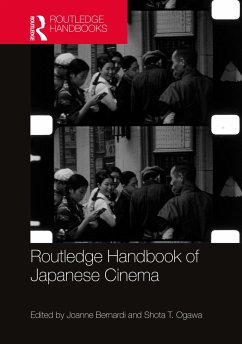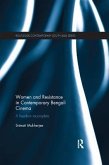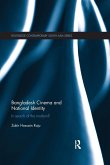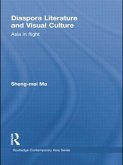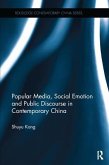Routledge Handbook of Japanese Cinema
Herausgeber: Bernardi, Joanne; Ogawa, Shota T.
Routledge Handbook of Japanese Cinema
Herausgeber: Bernardi, Joanne; Ogawa, Shota T.
- Broschiertes Buch
- Merkliste
- Auf die Merkliste
- Bewerten Bewerten
- Teilen
- Produkt teilen
- Produkterinnerung
- Produkterinnerung
The Routledge Handbook of Japanese Cinema provides a timely and expansive overview of Japanese cinema today, through cutting-edge scholarship that reflects the hybridity of approaches defining the field.
Andere Kunden interessierten sich auch für
![Women and Resistance in Contemporary Bengali Cinema Women and Resistance in Contemporary Bengali Cinema]() Srimati MukherjeeWomen and Resistance in Contemporary Bengali Cinema69,99 €
Srimati MukherjeeWomen and Resistance in Contemporary Bengali Cinema69,99 €![Bangladesh Cinema and National Identity Bangladesh Cinema and National Identity]() Zakir Hossain RajuBangladesh Cinema and National Identity72,99 €
Zakir Hossain RajuBangladesh Cinema and National Identity72,99 €![Popular Hindi Cinema Popular Hindi Cinema]() Ronie ParciackPopular Hindi Cinema65,99 €
Ronie ParciackPopular Hindi Cinema65,99 €![Chinese Documentaries Chinese Documentaries]() Yingchi ChuChinese Documentaries69,99 €
Yingchi ChuChinese Documentaries69,99 €![Women in Soviet Film Women in Soviet Film]() Women in Soviet Film65,99 €
Women in Soviet Film65,99 €![Diaspora Literature and Visual Culture Diaspora Literature and Visual Culture]() Sheng-Mei MaDiaspora Literature and Visual Culture77,99 €
Sheng-Mei MaDiaspora Literature and Visual Culture77,99 €![Popular Media, Social Emotion and Public Discourse in Contemporary China Popular Media, Social Emotion and Public Discourse in Contemporary China]() Shuyu KongPopular Media, Social Emotion and Public Discourse in Contemporary China69,99 €
Shuyu KongPopular Media, Social Emotion and Public Discourse in Contemporary China69,99 €-
-
-
The Routledge Handbook of Japanese Cinema provides a timely and expansive overview of Japanese cinema today, through cutting-edge scholarship that reflects the hybridity of approaches defining the field.
Hinweis: Dieser Artikel kann nur an eine deutsche Lieferadresse ausgeliefert werden.
Hinweis: Dieser Artikel kann nur an eine deutsche Lieferadresse ausgeliefert werden.
Produktdetails
- Produktdetails
- Verlag: Routledge
- Seitenzahl: 398
- Erscheinungstermin: 10. August 2020
- Englisch
- Abmessung: 246mm x 174mm x 21mm
- Gewicht: 706g
- ISBN-13: 9781138685529
- ISBN-10: 1138685526
- Artikelnr.: 69946353
- Herstellerkennzeichnung
- Books on Demand GmbH
- In de Tarpen 42
- 22848 Norderstedt
- info@bod.de
- 040 53433511
- Verlag: Routledge
- Seitenzahl: 398
- Erscheinungstermin: 10. August 2020
- Englisch
- Abmessung: 246mm x 174mm x 21mm
- Gewicht: 706g
- ISBN-13: 9781138685529
- ISBN-10: 1138685526
- Artikelnr.: 69946353
- Herstellerkennzeichnung
- Books on Demand GmbH
- In de Tarpen 42
- 22848 Norderstedt
- info@bod.de
- 040 53433511
Joanne Bernardi is Professor of Japanese/Film and Media, University of Rochester. Her background includes East Asian Studies, film preservation, filmmaking, and photography. She directs the Re-Envisioning Japan DH Project; publications include Japanese and silent cinema, film historiography, screenwriting, material culture, tourism, popular culture, and digital humanities. Shota T. Ogawa is Assistant Professor of Cinema Studies at Nagoya University, Japan. With a background in Visual and Cultural Studies, his research interests include postcolonial hybridity in Japanese cinema, tourism and travel films in imperial Japan, and trans-cultural migration of passing narratives.
Introduction Part 1: Decentering Classical Cinema: Modernity, Translation, and Mobilization 1. Suspense and Border Crossing: Ozu Yasujir
's Crime Melodrama 2. Beyond Mt. Fuji and the Lenin Cap: Identity Crisis in Taniguchi Senkichi's Akasen kichi (The Red Light Military Base, 1953) 3. Home Movies of the Revolution: Proletarian Filmmaking and Counter-Mobilization in Interwar Japan 4. When Marnie Was There: Female Friendship Film and the Genealogy of Queer Girls Culture 5. Making Sense of Nakai Masakazu's Film Theory, "Kino Satz" 6. Geysers of Another Nature: The Optical Unconscious of the Japanese Science Film Part 2: Questions of Industry: Critical Studies of Regulatory Frameworks, Creative Labor, and Distributive Networks 7. Kaiju Films as Exportable Content: Reassessing the Function of the Japanese Film Export Promotion Association 8. "Fugitives" from the Studio System: Ikebe Ry
, Sada Keiji, and the Transition from Cinema to Television in the Early 1960s 9. Solo Animation in Japan: Empathy for the Drawn Body 10. Media Models of "Amateur" Film and Manga Part 3: Intermedia as an Approach: Tracing Genealogies across Disciplines and Media 11. Utsushie: Japanese Magic Lantern Performance as Pre-cinematic Projection Practice 12. "Inter-Mediating" Global Modernity: Benshi Film Narrators, Multisensory Performance, and Fan Culture 13. Between Silent and Sound: The Liminal Space of the Japanese "Sound Version" 14. Marionettes No Longer: Politics in the Early Puppet Animation of Kawamoto Kihachir
15. Rhetorics of Autonomy and Mobility in Japanese "AAA" Games: The Metal Gear Solid and Resident Evil Series within a Global Media Context 16. Pointing Through the Screen: Archiving, Surveillance, and Atomization in the Wake of Japan's 2011 Triple Disasters Part 4: The Object Life of Film: Site-Specific Approaches to Japanese Cinema Studies 17. A Historical Survey of Film Archiving in Japan 18. Japanese Film History and the Challenges of IMAGICA WEST Corp. 19. A Case Study of Japanese Film Exhibition in North America: The Japan Society, New York 20. Regional Film Archive in Transit: Yasui Yoshio and Kobe Planet Film Archive 21. New Paths toward Preserving Japanese Cinema: The Toy Film Museum Backstory
's Crime Melodrama 2. Beyond Mt. Fuji and the Lenin Cap: Identity Crisis in Taniguchi Senkichi's Akasen kichi (The Red Light Military Base, 1953) 3. Home Movies of the Revolution: Proletarian Filmmaking and Counter-Mobilization in Interwar Japan 4. When Marnie Was There: Female Friendship Film and the Genealogy of Queer Girls Culture 5. Making Sense of Nakai Masakazu's Film Theory, "Kino Satz" 6. Geysers of Another Nature: The Optical Unconscious of the Japanese Science Film Part 2: Questions of Industry: Critical Studies of Regulatory Frameworks, Creative Labor, and Distributive Networks 7. Kaiju Films as Exportable Content: Reassessing the Function of the Japanese Film Export Promotion Association 8. "Fugitives" from the Studio System: Ikebe Ry
, Sada Keiji, and the Transition from Cinema to Television in the Early 1960s 9. Solo Animation in Japan: Empathy for the Drawn Body 10. Media Models of "Amateur" Film and Manga Part 3: Intermedia as an Approach: Tracing Genealogies across Disciplines and Media 11. Utsushie: Japanese Magic Lantern Performance as Pre-cinematic Projection Practice 12. "Inter-Mediating" Global Modernity: Benshi Film Narrators, Multisensory Performance, and Fan Culture 13. Between Silent and Sound: The Liminal Space of the Japanese "Sound Version" 14. Marionettes No Longer: Politics in the Early Puppet Animation of Kawamoto Kihachir
15. Rhetorics of Autonomy and Mobility in Japanese "AAA" Games: The Metal Gear Solid and Resident Evil Series within a Global Media Context 16. Pointing Through the Screen: Archiving, Surveillance, and Atomization in the Wake of Japan's 2011 Triple Disasters Part 4: The Object Life of Film: Site-Specific Approaches to Japanese Cinema Studies 17. A Historical Survey of Film Archiving in Japan 18. Japanese Film History and the Challenges of IMAGICA WEST Corp. 19. A Case Study of Japanese Film Exhibition in North America: The Japan Society, New York 20. Regional Film Archive in Transit: Yasui Yoshio and Kobe Planet Film Archive 21. New Paths toward Preserving Japanese Cinema: The Toy Film Museum Backstory
Introduction Part 1: Decentering Classical Cinema: Modernity, Translation, and Mobilization 1. Suspense and Border Crossing: Ozu Yasujir
's Crime Melodrama 2. Beyond Mt. Fuji and the Lenin Cap: Identity Crisis in Taniguchi Senkichi's Akasen kichi (The Red Light Military Base, 1953) 3. Home Movies of the Revolution: Proletarian Filmmaking and Counter-Mobilization in Interwar Japan 4. When Marnie Was There: Female Friendship Film and the Genealogy of Queer Girls Culture 5. Making Sense of Nakai Masakazu's Film Theory, "Kino Satz" 6. Geysers of Another Nature: The Optical Unconscious of the Japanese Science Film Part 2: Questions of Industry: Critical Studies of Regulatory Frameworks, Creative Labor, and Distributive Networks 7. Kaiju Films as Exportable Content: Reassessing the Function of the Japanese Film Export Promotion Association 8. "Fugitives" from the Studio System: Ikebe Ry
, Sada Keiji, and the Transition from Cinema to Television in the Early 1960s 9. Solo Animation in Japan: Empathy for the Drawn Body 10. Media Models of "Amateur" Film and Manga Part 3: Intermedia as an Approach: Tracing Genealogies across Disciplines and Media 11. Utsushie: Japanese Magic Lantern Performance as Pre-cinematic Projection Practice 12. "Inter-Mediating" Global Modernity: Benshi Film Narrators, Multisensory Performance, and Fan Culture 13. Between Silent and Sound: The Liminal Space of the Japanese "Sound Version" 14. Marionettes No Longer: Politics in the Early Puppet Animation of Kawamoto Kihachir
15. Rhetorics of Autonomy and Mobility in Japanese "AAA" Games: The Metal Gear Solid and Resident Evil Series within a Global Media Context 16. Pointing Through the Screen: Archiving, Surveillance, and Atomization in the Wake of Japan's 2011 Triple Disasters Part 4: The Object Life of Film: Site-Specific Approaches to Japanese Cinema Studies 17. A Historical Survey of Film Archiving in Japan 18. Japanese Film History and the Challenges of IMAGICA WEST Corp. 19. A Case Study of Japanese Film Exhibition in North America: The Japan Society, New York 20. Regional Film Archive in Transit: Yasui Yoshio and Kobe Planet Film Archive 21. New Paths toward Preserving Japanese Cinema: The Toy Film Museum Backstory
's Crime Melodrama 2. Beyond Mt. Fuji and the Lenin Cap: Identity Crisis in Taniguchi Senkichi's Akasen kichi (The Red Light Military Base, 1953) 3. Home Movies of the Revolution: Proletarian Filmmaking and Counter-Mobilization in Interwar Japan 4. When Marnie Was There: Female Friendship Film and the Genealogy of Queer Girls Culture 5. Making Sense of Nakai Masakazu's Film Theory, "Kino Satz" 6. Geysers of Another Nature: The Optical Unconscious of the Japanese Science Film Part 2: Questions of Industry: Critical Studies of Regulatory Frameworks, Creative Labor, and Distributive Networks 7. Kaiju Films as Exportable Content: Reassessing the Function of the Japanese Film Export Promotion Association 8. "Fugitives" from the Studio System: Ikebe Ry
, Sada Keiji, and the Transition from Cinema to Television in the Early 1960s 9. Solo Animation in Japan: Empathy for the Drawn Body 10. Media Models of "Amateur" Film and Manga Part 3: Intermedia as an Approach: Tracing Genealogies across Disciplines and Media 11. Utsushie: Japanese Magic Lantern Performance as Pre-cinematic Projection Practice 12. "Inter-Mediating" Global Modernity: Benshi Film Narrators, Multisensory Performance, and Fan Culture 13. Between Silent and Sound: The Liminal Space of the Japanese "Sound Version" 14. Marionettes No Longer: Politics in the Early Puppet Animation of Kawamoto Kihachir
15. Rhetorics of Autonomy and Mobility in Japanese "AAA" Games: The Metal Gear Solid and Resident Evil Series within a Global Media Context 16. Pointing Through the Screen: Archiving, Surveillance, and Atomization in the Wake of Japan's 2011 Triple Disasters Part 4: The Object Life of Film: Site-Specific Approaches to Japanese Cinema Studies 17. A Historical Survey of Film Archiving in Japan 18. Japanese Film History and the Challenges of IMAGICA WEST Corp. 19. A Case Study of Japanese Film Exhibition in North America: The Japan Society, New York 20. Regional Film Archive in Transit: Yasui Yoshio and Kobe Planet Film Archive 21. New Paths toward Preserving Japanese Cinema: The Toy Film Museum Backstory

